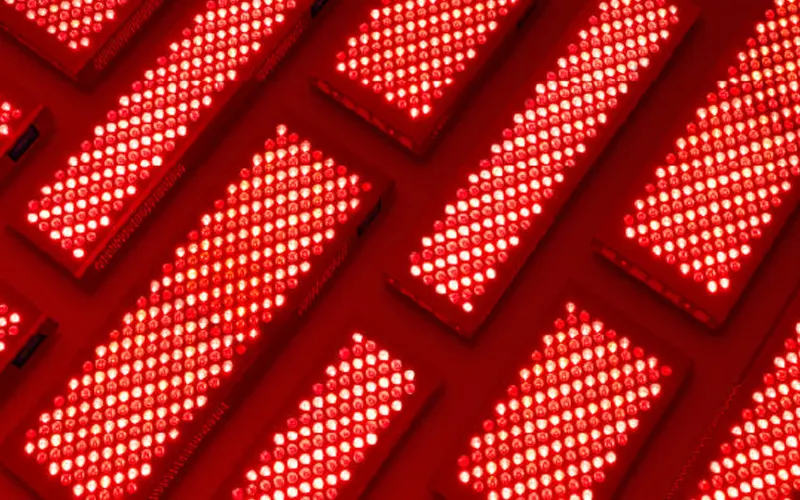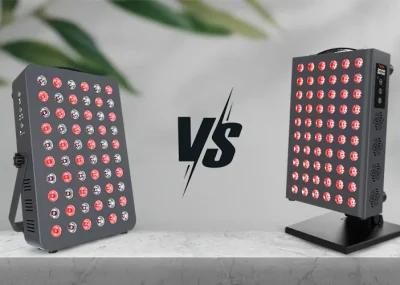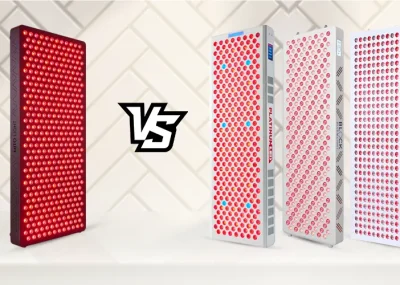The 660nm wavelength holds a special place in the fascinating world of light therapy. This specific part of the light spectrum is associated with several health benefits and is attracting growing interest from both wellness enthusiasts and scientists.
In this guide, we’ll learn about the 660nm wavelength, explaining its nature, how it’s produced, and what makes it unique. We look into the body of research that supports its myriad health benefits, from skin health to cognitive performance. We also provide practical advice on how to safely and effectively use this wavelength for its potential benefits.
Along the way, we’ll address common questions to ensure a well-rounded understanding of this intriguing subject.
Ready? Welcome to the world of the 660nm wavelength.
Understanding the 660nm Wavelength
The 660nm wavelength falls within the red light spectrum. This specific band of light isn’t visible to the naked eye but has noteworthy effects on cellular function.
A key feature of the 660nm wavelength is its ability to penetrate the skin. Unlike other wavelengths that merely bounce off the skin’s surface, the 660nm wavelength sinks deeper, reaching cells and tissues beneath. It’s here that the wavelength interacts with our mitochondria, the ‘powerhouses’ of our cells. This interaction stimulates a process called photobiomodulation[6].
Photobiomodulation involves the absorption of light energy to stimulate cellular activity. Specifically, the 660nm wavelength encourages cells to produce more adenosine triphosphate (ATP), the energy currency of life. With more ATP, cells can function more efficiently and regenerate faster[1].
This underpins many of the health benefits associated with the 660nm wavelength. From skin health and wound healing to cognitive function and pain relief, the potential applications are broad and varied.
The Health Benefits of the 660nm Wavelength
The ability of 660nm wavelength to stimulate cellular function has led to numerous potential health benefits. Here’s the science behind these claims:
Skin Health and Anti-Aging
When applied to the skin, the 660nm wavelength encourages cells to produce more collagen, a protein that keeps our skin firm and youthful.
A study by Photomed Laser Surg shows a significant reduction in wrinkles and fine lines after regular exposure to this wavelength. Moreover, it can improve the complexion by reducing inflammation and increasing blood flow[2].
Cognitive Function
Beyond skin health, the 660nm wavelength also shows promise in enhancing cognitive performance. Research indicates that it can improve memory and attention, likely due to increased ATP production leading to better neuronal function. This offers hope for managing conditions like Alzheimer’s and Parkinson’s disease[3].
Pain Relief and Muscle Recovery
The anti-inflammatory properties of the 660nm wavelength can help relieve pain. It reduces inflammation, a major factor in chronic pain conditions. Additionally, it aids in muscle recovery post-exercise by promoting cellular repair and recovery[4].
Hair Growth
Interestingly, the 660nm wavelength may also stimulate hair growth. By increasing blood flow to hair follicles and stimulating cellular energy, it has been found to promote healthier and thicker hair[5].
How to Harness the Benefits of the 660nm Wavelength
Here’s how you can integrate the 660nm wavelength into your wellness routine.
Devices for Red Light Therapy
The most common way to harness the 660nm wavelength is through red light therapy devices. These include LED panels, handheld devices, and even wearable tech like masks or caps. When choosing a device, ensure it emits light at the correct wavelength.
Duration and Frequency of Use
The effectiveness of red light therapy depends largely on consistent and regular use. Most studies suggest sessions lasting 10-20 minutes, performed several times a week. However, the optimal duration and frequency may vary depending on individual needs and the specific health benefit you’re seeking.
Safety Precautions
While the 660nm wavelength is generally safe, it’s important to take certain precautions. Avoid looking directly at the light source to protect your eyes. If you’re using the light for skin health, ensure your skin is clean and free of makeup or other products that could interfere with light absorption.
When engaging in red light therapy, protecting your eyes is crucial to prevent any potential harm from the bright lights used in the process. This is where blackout goggles come into play, ensuring complete blockage of the therapy light to safeguard your vision. For the best protection, check out our guide to the Best Blackout Goggles to find a pair that suits your needs.
Frequently Asked Questions
Can the 660nm wavelength penetrate clothing?
A: The effectiveness of the 660nm wavelength can be diminished by clothing. Direct skin exposure is recommended for optimum results.
Is the 660nm wavelength safe for all skin types?
A: Yes, research suggests that the 660nm wavelength is safe for all skin types. However, individuals with specific light-sensitive conditions should consult a healthcare professional before use.
Can I overdo it with the 660nm wavelength therapy?
A: While the 660nm wavelength is generally safe, excessive exposure could potentially lead to skin redness or discomfort. Following the recommended duration and frequency of use is crucial.
How soon can I see results from using the 660nm wavelength?
A: Results can vary greatly between individuals and the specific health benefit sought. Some might notice improvements within a few weeks, while others may require several months of consistent use.
Can I use other skincare products along with the 660nm wavelength therapy?
A: Yes, the 660nm wavelength can complement other skincare routines. However, ensure your skin is clean and free of products during light therapy sessions for maximum light absorption.
What wavelength is healing?
A: Wavelength healing is the use of specific light wavelengths to stimulate the body’s natural healing processes. Notably, red and near-infrared light, typically in the range of 600-900nm, have shown promising results in promoting wound healing and reducing inflammation.
Can pregnant women use red light therapy devices emitting the 660nm wavelength?
A: While red light therapy is generally considered safe, its effects on pregnant women have not been extensively studied. Therefore, pregnant women should consult their physician before starting red light therapy.
What is the recommended distance between the red light therapy device and the skin for optimal results?
A: The optimal distance can vary depending on the specific device and treatment. However, a common recommendation is to position the device around 6-12 inches away from the skin. Always refer to the manufacturer’s guidelines.
Conclusion
The 660nm wavelength, a key player in red light therapy, presents an intriguing blend of science and wellness. Its potential to rejuvenate skin, enhance cognitive function, aid muscle recovery, and even stimulate hair growth is backed by considerable research. However, to effectively harness these benefits, understanding the correct use of therapy devices, duration, frequency, and safety precautions is crucial.
Additionally, for those interested in the benefits of red light therapy for athletic recovery and regeneration, the Arc Athlete Recovery Surge Regeneration Review offers valuable insights and comparisons. Integrating information from this review can help individuals make informed decisions, improving their well-being and achieving desired results effectively.
We hope this guide has provided a comprehensive overview of the 660nm wavelength’s potential and how to incorporate it into your routine. Remember, while this therapy offers promising benefits, it’s essential to consult with a healthcare provider for any health concerns.







